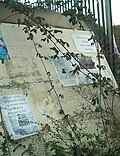Carrickmines Castle
| Carrickmines Castle | |
| County Dublin | |
|---|---|
| Location | |
| Grid reference: | O21812408 |
| Location: | 53°15’12"N, 6°10’31"W |
| History | |
| Information | |
| Condition: | Sections of wall foundations remain |
Carrickmines Castle stood by in Carrickmines in County Dublin, and today the site of the castle is an archaeological site. The castle was built in the Middle Ages to protect the Pale around Dublin. The mostly subsurface ruins lay in the path of the M50 motorway, completed in 2005. Sections of the mediæval walls and some sections of the castle's defensive structures were preserved within or under M50 roundabouts.
History
Carrickmines Castle was the site of a Hiberno-Norse settlement which during the 12th century became a fortified Norman castle and village, on the frontier between Dublin and Wicklow, Ireland. Guarding the southern plains, this fortress was once a central medallion in the necklace of the Norman castles and outposts dotted along the outskirts of The Pale – the area around Dublin under English rule during the Middle Ages.
In 1402 the O'Byrne clan of County Wicklow, who periodically raided Dublin, moved a large mercenary force to the banks of the River Dargle at Bray, but, as the direct route to the city would bring them close to the stronghold of Carrickmines, they apparently hesitated before attacking. The delay allowed the Walsh family, who owned Carrickmines, to send an urgent warning to Dublin. The Dubliners responded decisively: the Mayor of Dublin with a large force fell on the O'Byrnes and defeated them, in an encounter popularly known as the Battle of Bloody Bank, due to the number of casualties.
As a major fortress, Carrickmines had an extensive curtain wall flanked by towers protecting an area of some acres. Within this was settlement with a variety of wooden and stone buildings, mills, and a keep or hall house in the centre. The site still contains impressive defences, hewn into bedrock, and human remains from when the castle was overwhelmed in 1642.
In the Irish Rebellion of 1641, the Roman Catholic Walsh family who owned the Castle sided with the native Irish and the Confederate rebels. They paid dearly – as a focus of the Irish Confederate Wars, the Castle was besieged by English forces, and when it was retaken over 300 of the Walsh, O'Byrne, and O'Tooles were massacred.
M50 motorway and "The Carrickminders"

The ruins of the castle were the subject of a long running dispute before the M50 motorway was built through the site of the castle. It began in 2002 when activists who called themselves the "Carrickminders" camped out on the castle's ruins to prevent them being removed to make way for the motorway. They were joined by preservationists, including Professor Sean Duffy, Head of the Department of History at Trinity College Dublin and Dr. Mark Clinton, who was the archaeologist employed by the National Roads Authority as Site Director. They argued that the site's potential for historical study had not been fully realised. They questioned why the line of the M50 rerouted through the castle in 1998 when the proposed new road was originally routed around it in 1983 on the advice of a state agency.
In 2005 both the M50 motorway and the junction were completed.
The matter created a legal challenge, which went all the way up to the Supreme Court of Ireland in July 2006, at which the court unanimously upheld the constitutionality of new laws affecting the preservation of the Carrickmines Castle site, and the decision of the Minister for the Environment, Heritage and Local Government. The ruling allowed the road works at Carrickmines Castle to proceed notwithstanding that the castle ruins were a national monument and that a large part of a moat discovered at the site would cease to exist.
Photo gallery
-
Remains of the Carrickminders' camp, January 2004
-
Minding the Carrickminders
-
Water feature discovered


